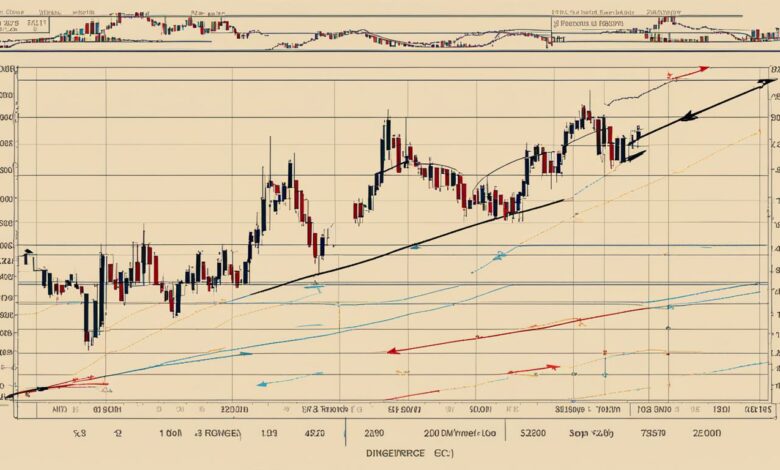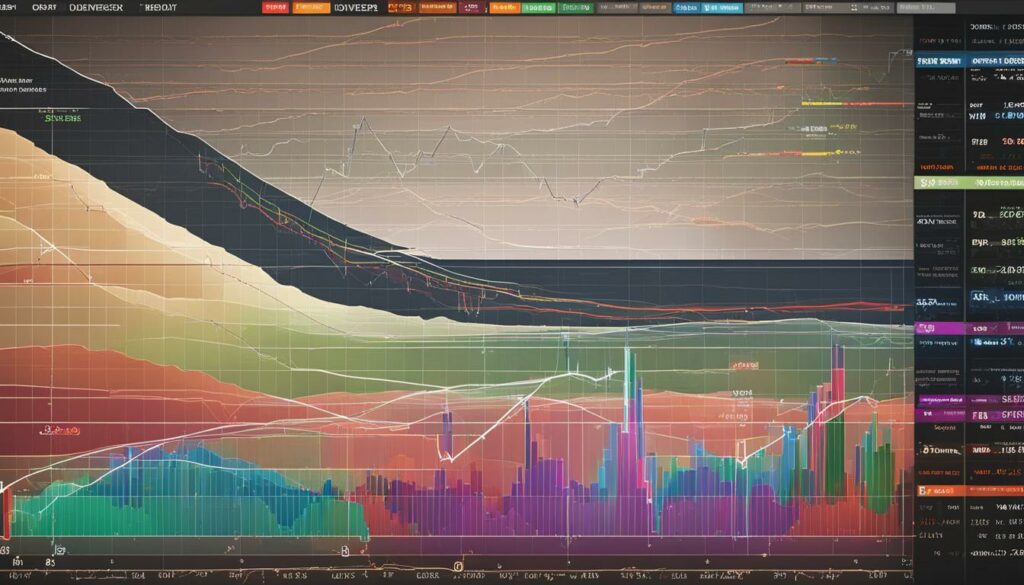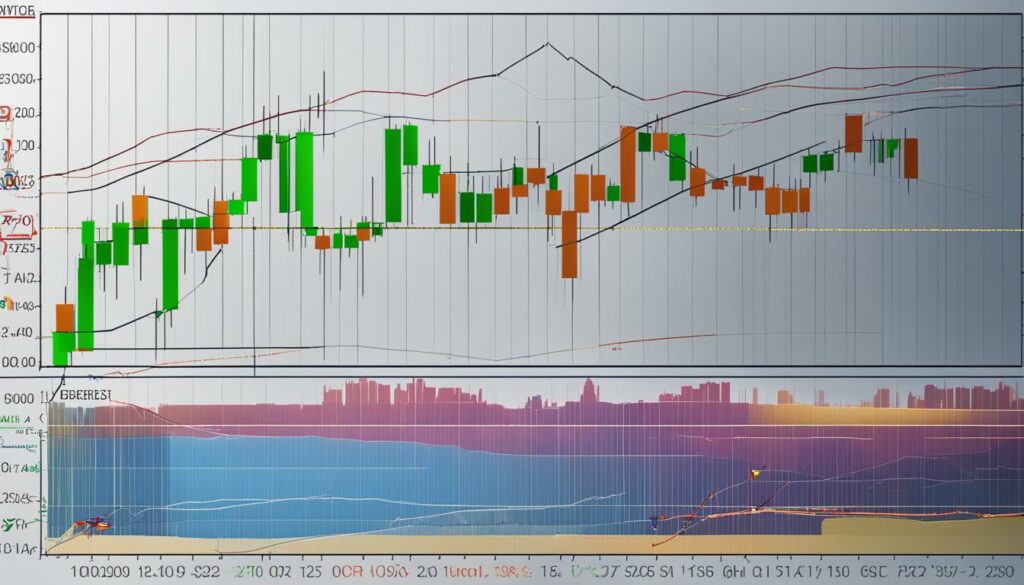Divergence Meaning: How Spotting Reversals Can Help You Trade Smarter

Welcome to our article on divergence in trading! In this guide, we will explore the meaning of divergence and how it can help you spot potential trend reversals, allowing you to trade smarter. By understanding and identifying divergence, you can enhance your trading strategies and make more informed decisions in the market.
Key Takeaways:
- Divergence in trading refers to the disagreement between price and momentum indicators.
- Identifying divergence can provide insights into potential trend reversals or trend continuations.
- Traders can use various technical indicators to spot divergence and incorporate it into their trading strategies.
- There are two main types of divergence: regular divergence and hidden divergence.
- Divergence trading has its benefits and risks, so it’s important to weigh the pros and cons.
Understanding Price Momentum and Its Importance in Trading
Price momentum plays a crucial role in assessing trend strength and evaluating potential trading opportunities. It refers to the direction and magnitude of price movements, indicating the rate at which prices are changing. By understanding price momentum, traders can gain valuable insights into the market and make more informed trading decisions.
Evaluating price momentum involves analyzing the length and steepness of price swings. A strong momentum is characterized by steep slopes and long price swings, indicating a significant and sustained price movement. Conversely, weak momentum is indicated by shallow slopes and short price swings, suggesting a lack of momentum.
Traders can use various momentum indicators to evaluate price momentum. These indicators, such as the Relative Strength Index (RSI), Stochastics, and the Rate of Change, help traders identify overbought or oversold conditions, potential trend reversals, and trend continuations. By incorporating these indicators into their trading strategies, traders can gauge the strength of a trend and make more precise trading decisions.
| Momentum Indicator | Definition | Usage |
|---|---|---|
| Relative Strength Index (RSI) | A momentum oscillator that measures the speed and change of price movements. | Identify overbought or oversold conditions and potential trend reversals. |
| Stochastics | A momentum indicator that compares a security’s closing price to its price range over a specific period. | Identify overbought or oversold conditions and potential trend reversals. |
| Rate of Change | A momentum oscillator that measures the percentage change in price over a specified period. | Identify the strength of a trend and potential trend continuations. |
By effectively evaluating price momentum and utilizing momentum indicators, traders can gain a deeper understanding of market dynamics and enhance their trading strategies. Evaluating price momentum allows traders to assess the strength of a trend, identify potential entry and exit points, and manage risk more effectively. Incorporating price momentum analysis into their trading approach can significantly improve trading outcomes and increase the chances of success.
The Concept of Divergence in Trading
Divergence in trading refers to the disagreement between price and momentum indicators. When price and indicators show opposite patterns, it is called regular divergence, indicating a potential trend reversal. On the other hand, when price and indicators show consistent patterns, it is known as hidden divergence, indicating a potential trend continuation. Understanding and identifying divergence is crucial for trade management and making informed trading decisions.
Regular Divergence:
| Price | Indicator | Pattern | Implication |
|---|---|---|---|
| Rising | Falling | Bearish Divergence | Potential trend reversal |
| Falling | Rising | Bullish Divergence | Potential trend reversal |
Hidden Divergence:
| Price | Indicator | Pattern | Implication |
|---|---|---|---|
| Rising | Rising | Bullish Hidden Divergence | Potential trend continuation |
| Falling | Falling | Bearish Hidden Divergence | Potential trend continuation |
Divergence can have significant implications for trade management. Traders can use regular divergence to identify potential trend reversals and adjust their trading strategies accordingly. Similarly, hidden divergence can help traders confirm and participate in ongoing trends. It is essential for traders to understand the different types of divergence and their implications for trade management in order to make informed decisions and maximize trading profits.
Identifying Divergence in Trading
Identifying divergence in trading is crucial for traders who want to enhance their trading strategies and make more informed decisions. By spotting divergence, traders can potentially identify trend reversals or continuations, allowing them to enter or exit positions at opportune moments. Here are some key steps and indicators to help you effectively identify divergence in trading.
The Relative Strength Index (RSI)
The RSI is a popular momentum indicator that can be used to identify divergence in trading. It measures the speed and change of price movements and indicates overbought or oversold conditions. When the price is making higher highs but the RSI is making lower highs, it suggests a bearish divergence. Conversely, when the price is making lower lows but the RSI is making higher lows, it indicates a bullish divergence. The RSI can be a valuable tool in identifying potential trend reversals or continuations.
The Moving Average Convergence Divergence (MACD)
The MACD is another powerful indicator that can be used to identify divergence in trading. It consists of two lines – the MACD line and the signal line – and a histogram that represents the difference between the two lines. When the price is making higher highs but the MACD line is making lower highs, it suggests a bearish divergence. On the other hand, when the price is making lower lows but the MACD line is making higher lows, it indicates a bullish divergence. The MACD can provide valuable insights into potential trend reversals or continuations.
Trend Lines and Chart Patterns
Traders can also use trend lines and chart patterns to confirm divergence signals and strengthen their trading decisions. By drawing trend lines connecting the highs or lows of price movements, traders can visually identify divergence more easily. Additionally, chart patterns such as double tops or double bottoms can serve as confirmation of divergence. These technical analysis tools can help traders validate divergence signals and increase the accuracy of their trading strategies.
Overall, identifying divergence in trading is a skill that can greatly improve traders’ decision-making process. By using indicators such as the RSI and MACD, as well as trend lines and chart patterns, traders can effectively identify potential trend reversals or continuations. Incorporating divergence into trading strategies can enhance overall trading performance and help traders stay ahead in the market.

Types of Divergence in Trading
Regular divergence and hidden divergence are the two main types of divergence in trading. Understanding the characteristics and differences between these types is crucial for traders looking to incorporate divergence into their trading strategies.
Regular divergence occurs when price and indicators show opposite patterns, indicating a potential trend reversal. For example, if the price is making lower lows while the indicator is making higher lows, it suggests that the current downtrend may be losing momentum and a reversal could be imminent. This type of divergence can provide valuable insights for traders to exit or reverse their positions.
Hidden divergence, on the other hand, occurs when price and indicators show consistent patterns, indicating a potential trend continuation. It typically occurs during a retracement within an existing trend. For instance, if the price makes higher lows while the indicator makes lower lows, it suggests that the uptrend is still intact, and the retracement may present a buying opportunity. Traders can use hidden divergence to add to their existing positions or enter new trades in the direction of the prevailing trend.
To visually illustrate the differences between regular and hidden divergence, refer to the table below:
| Regular Divergence | Hidden Divergence |
|---|---|
| Opposite patterns between price and indicators | Consistent patterns between price and indicators |
| Potential trend reversal | Potential trend continuation |
| Higher probability of trade reversal or exit | Higher probability of trade continuation |
It is important for traders to recognize and analyze both types of divergence in order to make well-informed trading decisions. Regular divergence can be a powerful tool for identifying potential trend reversals, while hidden divergence can provide opportunities to capitalize on trend continuations. By understanding the characteristics and implications of these types of divergence, traders can better incorporate them into their trading strategies and improve their overall trading performance.
Remember, while divergence can be a valuable tool, it should be used in conjunction with other technical analysis tools and confirmation techniques to increase its reliability as a predictive tool in trading.

Pros and Cons of Divergence Trading
Divergence trading offers several benefits to traders, which can enhance their trading strategies and decision-making process. By spotting potential trend reversals or continuations, traders can capitalize on market opportunities and improve their overall trading performance. Some of the key benefits of trading with divergence include:
- Early signals: Divergence can provide traders with early indications of potential trend reversals or continuations, allowing them to enter or exit positions ahead of the crowd.
- Informed trading decisions: By understanding and incorporating divergence into their analysis, traders can make more informed trading decisions based on the disagreement between price and momentum indicators.
- Improved trade management: Divergence can help traders manage their trades better by providing insights into potential trend reversals or continuations, allowing them to adjust their stop-loss levels or take profit targets accordingly.
However, it is important to evaluate the pros and cons of divergence trading before fully adopting it as a trading strategy. There are also risks and drawbacks associated with divergence trading that traders should be aware of:
- Challenging identification: Accurately identifying and interpreting divergence signals can be challenging, as false signals can occur, leading to potential losses if not properly managed.
- Need for confirmation: Divergence signals should be used in conjunction with other technical analysis tools and confirmation techniques to increase their reliability. Relying solely on divergence signals may result in false or unreliable trading decisions.
- Market conditions: Divergence trading may work better in certain market conditions and may be less effective in others. Traders should adapt their strategies and use other technical analysis tools to evaluate market conditions before relying solely on divergence signals.
Overall, traders need to carefully evaluate the pros and cons of divergence trading and assess its suitability for their trading style and risk tolerance. Incorporating divergence into a comprehensive trading strategy, along with proper risk management techniques, can potentially yield positive results in the long run.
Using Technical Indicators to Identify Divergence
When it comes to identifying divergence in trading, there are a variety of technical indicators that can be used. These indicators provide valuable insights into the relationship between price and momentum, helping traders anticipate potential trend reversals or continuations. By incorporating these indicators into their analysis, traders can gain a better understanding of the market dynamics and make more informed trading decisions.
Some of the commonly used technical indicators for identifying divergence include the Relative Strength Index (RSI), Moving Average Convergence Divergence (MACD), Stochastic Oscillators, and many others. These indicators use mathematical calculations to measure price and momentum, allowing traders to spot discrepancies that may indicate a potential change in the market direction.
It’s important to note that while divergence can be a reliable predictive tool in trading, it should not be used in isolation. Traders should combine divergence analysis with other technical analysis tools and confirmation techniques to increase its reliability. By doing so, traders can reduce the risk of false signals and enhance the accuracy of their trading strategies.
| Technical Indicator | Description |
|---|---|
| Relative Strength Index (RSI) | A momentum oscillator that measures the speed and change of price movements. It compares the magnitude of recent gains to recent losses to determine overbought or oversold conditions. |
| Moving Average Convergence Divergence (MACD) | A trend-following momentum indicator that shows the relationship between two moving averages of a security’s price. It helps identify the strength, direction, and duration of a trend. |
| Stochastic Oscillators | A momentum indicator that compares a security’s closing price to its price range over a specific period. It helps identify overbought and oversold conditions. |
“Divergence analysis can be a powerful tool for traders, as it provides insights into potential trend reversals or continuations. By using technical indicators to identify divergence, traders can gain a better understanding of market dynamics and make more informed trading decisions.”
Using Technical Indicators to Identify Divergence
- Choose the appropriate technical indicators based on your trading strategy and market conditions.
- Look for discrepancies between price and momentum indicators that may indicate potential divergence.
- Confirm divergence signals with other technical analysis tools and techniques.
- Consider the overall market context and fundamental factors when interpreting divergence signals.
- Regularly evaluate the effectiveness of your divergence trading strategy and make adjustments as necessary.

Mastering Divergence Trading Techniques
In order to become proficient in divergence trading, it is essential to dedicate time and effort to mastering the techniques involved. Developing a deep understanding of price momentum and technical indicators is crucial for accurately identifying and interpreting divergence signals. Here are some key steps to help you enhance your divergence trading skills:
- Study chart patterns: Analyzing different chart patterns can provide valuable insights into potential trend reversals or continuations. Familiarize yourself with common patterns such as head and shoulders, double tops or bottoms, and triangles.
- Refine technical analysis skills: Continuously improving your technical analysis skills will enable you to make more informed trading decisions. Learn how to effectively use indicators and oscillators, trendlines, support and resistance levels, and other technical tools.
- Monitor market conditions: Stay updated on market news and events that may impact the assets you are trading. Monitor price movements, trading volumes, and other relevant market indicators to identify potential trading opportunities.
- Implement proper risk management: Managing risk is crucial in any trading strategy. Set stop-loss orders to limit potential losses and adhere to proper position sizing principles. Regularly review and adjust your risk management strategy as needed.
Remember, mastering divergence trading techniques is a continuous learning process. Keep practicing, analyzing your trades, and refining your strategies. Adapt your approach to different market conditions and be open to learning from both successful and unsuccessful trades. By consistently honing your skills, you can take full advantage of the potential opportunities that divergence trading offers.
“The key to success in divergence trading lies in continuous practice, analysis, and adaptation.”
| Pros | Cons |
|---|---|
| Divergence provides early signals for potential trend reversals or continuations. | Accurately identifying and interpreting divergence signals can be challenging. |
| Helps traders make more informed trading decisions. | False signals can lead to losses. |
| Can be used in conjunction with other technical analysis tools for increased reliability. | Requires continuous monitoring of market conditions. |
By following these steps and considering both the pros and cons of divergence trading, you can enhance your trading skills and potentially improve your overall trading performance. Remember that practice, discipline, and continuous learning are key to mastering divergence trading techniques.

Evaluating Divergence and Confirmation
When using divergence as a trading strategy, it is crucial for traders to evaluate both divergence and confirmation. While divergence provides valuable insights into potential trend reversals or continuations, confirmation acts as an additional layer of validation to increase the reliability of divergence signals. By understanding the difference and significance between these two concepts, traders can make more informed trading decisions.
Divergence refers to the disagreement between price and momentum indicators. It occurs when price and indicators show opposite or consistent patterns, indicating potential trend reversals or continuations, respectively. However, relying solely on divergence signals can be risky, as false signals can result in losses. This is where confirmation comes into play.
Confirmation involves using additional technical analysis tools and techniques to validate divergence signals. It can include analyzing other indicators, chart patterns, or support and resistance levels to confirm the potential reversal or continuation indicated by divergence. By waiting for confirmation, traders can increase their confidence in the accuracy of their trading decisions.
| Difference between Divergence and Confirmation | Significance of Divergence and Confirmation |
|---|---|
| Divergence | Provides insights into potential trend reversals or continuations |
| Confirmation | Acts as an additional layer of validation for divergence signals |
| Divergence | Can be risky if relied upon solely for trading decisions |
| Confirmation | Increases confidence in the accuracy of trading decisions |
By evaluating both divergence and confirmation, traders can enhance the effectiveness of their trading strategies. It is important to remember that divergence should not be used in isolation, and confirmation should be sought for increased reliability. Through a comprehensive analysis of both concepts, traders can make well-informed trading decisions and improve their overall trading performance.

Conclusion
In conclusion, divergence is an essential concept in trading that can greatly benefit traders in spotting potential trend reversals or continuations. By understanding and incorporating divergence into their trading strategies, traders can make more informed decisions and improve their overall trading performance.
Divergence, as defined in trading, refers to the disagreement between price and momentum indicators. It can provide valuable insights into the market and help traders anticipate potential changes in trends. By identifying and interpreting divergence signals, traders can gain an edge in their trading strategies and improve their chances of success.
It is important to note that mastering divergence trading techniques requires practice, experience, and continuous learning. Traders should continuously refine their technical analysis skills, study chart patterns, and adapt their strategies to suit different trading markets and conditions. Additionally, implementing proper risk management strategies and evaluating the effectiveness of divergence in their trading strategies can contribute to mastering divergence trading techniques.
In summary, understanding the meaning and definition of divergence in trading, as well as its importance, is crucial for traders looking to enhance their trading strategies. By incorporating divergence into their analysis and decision-making process, traders can navigate the markets more effectively and potentially achieve greater profitability.
FAQ
What is divergence in trading?
Divergence in trading refers to the disagreement between price and momentum indicators, providing insights into potential trend reversals or continuations.
How is price momentum evaluated in trading?
Price momentum is evaluated by measuring the length and steepness of price swings, with strong momentum indicated by steep slopes and long swings.
What are the types of divergence in trading?
There are two main types of divergence – regular divergence, indicating a potential trend reversal, and hidden divergence, indicating a potential trend continuation.
How can I identify divergence in trading?
Traders can use technical indicators such as RSI, MACD, and stochastic oscillators, as well as trend lines and chart patterns to identify divergence.
What are the benefits and drawbacks of divergence trading?
Divergence trading can provide early signals for potential reversals or continuations, but it also carries risks such as false signals which can lead to losses.
Which technical indicators can be used to identify divergence?
Technical indicators such as RSI, MACD, stochastic oscillators, and MACD can be used to identify divergence in trading.
Can divergence be applied in different trading markets?
Yes, divergence can be applied in various markets including stocks, commodities, and forex, with adjustments made to suit the specific characteristics of each market.
How can I master divergence trading techniques?
Mastering divergence trading techniques requires practice, studying chart patterns, refining technical analysis skills, and continuously monitoring market conditions.
What is the difference between divergence and confirmation?
Divergence refers to the disagreement between price and indicators, while confirmation involves using additional tools to validate divergence signals.







